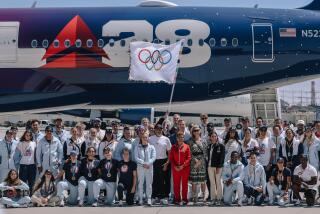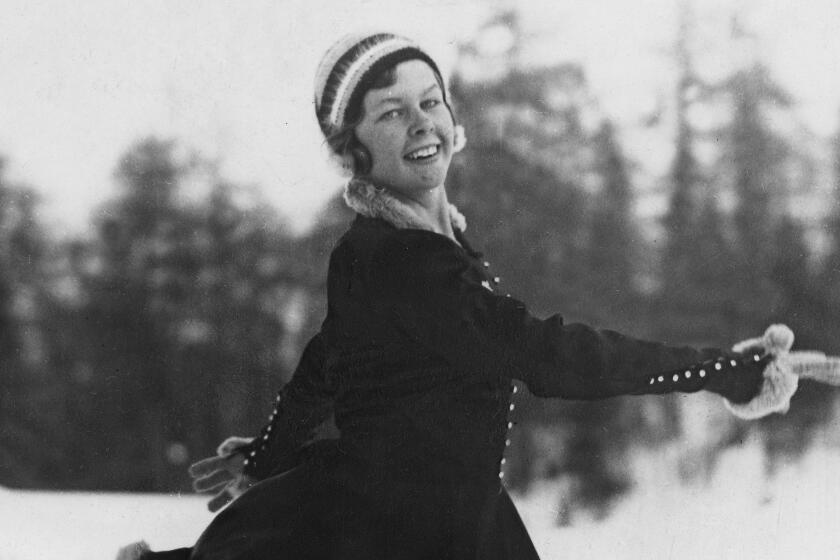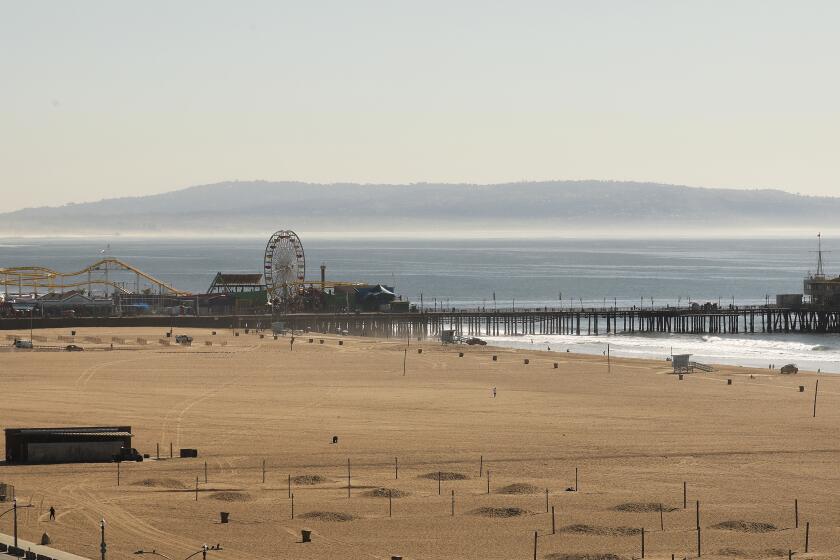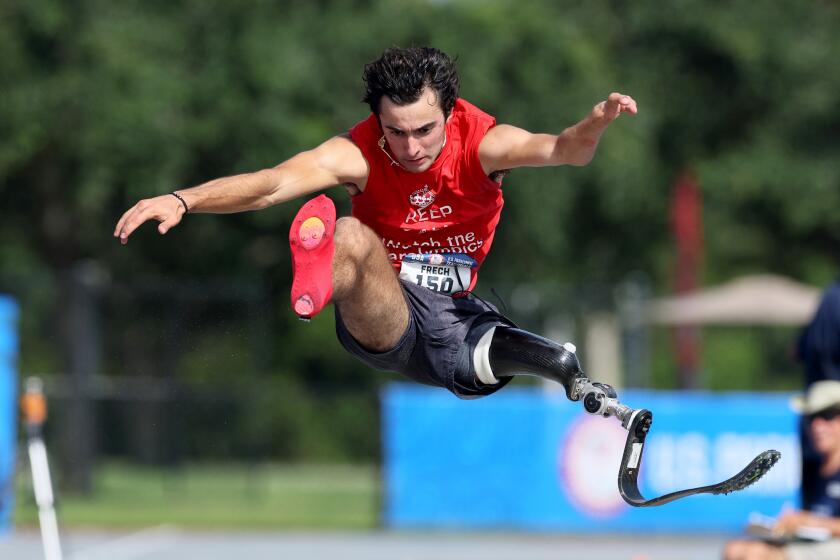An Economy Lesson in Paris
PARIS — As an International Olympic Committee task force evaluating this city’s bid for the 2012 Summer Games made its way a few days ago around the Stade de France, the stadium built for soccer’s 1998 World Cup, a video blazed into action on one of the jumbo scoreboards.
Here came flashes of soccer glory, of rugby thrills, of the 2003 track and field world championships staged at the multipurpose stadium. Here, too, came footage of the Rolling Stones and of AC/DC banging it out on a Stade de France stage.
The point, of course, was not to wow the IOC -- hardly a bunch of headbangers -- with AC/DC. Instead, the video made clear what the French would not, with French politesse, say directly: Unlike rivals in London and New York, Paris has a stadium on the ground, one that can handle the theater of an Olympics opening ceremony and an elite track and field meet.
In part because Paris has its would-be Olympic stadium, Paris organizers have opted for an unusual twist, one that may play a key role in the July 6 vote for the 2012 Games: 13 of the structures that would go up for a Paris 2012 Olympics are temporary pavilions.
The use of such temporary venues is in keeping with a 2003 IOC study that noted the soaring costs of Games-related building as cities increasingly view the Olympics as a catalyst to fast-track urban regeneration.
Beijing will spend more than $30 billion readying for the 2008 Games. Athens spent more than $10 billion gearing up for 2004, and now is confronting the bill.
To a far greater degree than its four competitors in the 2012 race, Paris is relying on that 2003 report as a gospel preaching the virtue of temporary venues; Moscow is proposing the use of four temporary venues, Madrid five, New York six, London seven.
At 13, the Paris bid thus offers a template for how, in line with the aim of IOC President Jacques Rogge, the Games might in the future go to Africa or South America. Neither continent has staged the Olympics.
“I think it’s a very interesting answer for the future of the Games,” said Philippe Baudillon, chief executive of the Paris 2012 bid committee.
Since 1896, the Games have rotated among the United States and Canada, Europe and Australia, with appearances by Japan, Mexico and South Korea.
Beijing’s winning bid for 2008 has given impetus to plans all over the world.
Havana and Rio de Janeiro were among those in the early running for the 2012 race.
Kenya has said it might vie for the 2016 Games. Another African nation, Ghana, announced recently an intent to bid for the 2032 Olympics. Tel Aviv has even investigated the possibility of a bid; it came up with a slogan which, roughly translated, said, “It’s OK to dream.”
An aide to Prince Feisal Al-Hussein, the head of Jordan’s Olympic committee, shadowed the IOC panel as it made its way around Paris in a four-day visit that ended Saturday. Jordan is weighing the possibility of bidding for the 2014 Asian Games.
The aide, David Williams, said Jordan would need $3 billion in infrastructure to even consider a 2014 Asian Games bid. But he said, “Unless you’re ambitious and you go for it, you stand still.”
The math that underlies the Paris 2012 plan leaps out to the cost-conscious.
For $225 million, according to detailed financial records that the five cities have supplied to the IOC, Paris would deliver temporary venues for basketball, boxing, weightlifting, table tennis, wrestling and taekwondo, handball, fencing, equestrian and modern pentathlon, archery, triathlon, cycling, beach volleyball, baseball, softball and the start of the marathon.
For $225 million, Madrid would build a permanent tennis center.
Most IOC elections traditionally swing on personal relationships and sports politics, not on so-called “technical” matters such as temporary venues or transportation. Nawal el Moutawakel of Morocco, chairwoman of the IOC commission, stung Paris backers at a news conference Saturday by disclosing that the panel was “concerned” about transportation issues at the 2003 track and field meet and was “closely analyzing” the matter.
Nonetheless, as the 2012 contest moves into high gear, the Paris pavilions plan has emerged for some as an intriguing referendum, not only about Paris but the direction of the IOC.
“It’s a real choice,” asserted Jean-Francois Lamour, France’s minister for sports.
Asked about the significance of temporary venues, El Moutawakel said, “This will be in our report,” to be issued in June. A few moments earlier, asked about the Paris stadium, she had said, “Of course having infrastructure already ready is something very important to our process.”
The Paris proposal has sparked debate within Olympic circles about what the IOC calls “legacy,” the idea that the Games should leave a mark on a city without leaving behind “white elephants,” meaning sports facilities -- as in Athens -- that sit empty after the glamour of the Games has faded away.
All five bid cities insist they will produce no elephants. All five profess a dedication to legacy.
Tessa Jowell, the British cabinet minister responsible for the London bid, said, “It is not enough to just want to stage the Olympics because it is a fabulous festival of sport.
“There has to be more, a clear intention to leave something positive, even magical, behind when the athletes depart.”
All five cities, even Paris, plan billions in infrastructure improvements for 2012, underwritten mostly by governments.
London, for instance, plans $15.8 billion in capital investment as part of a plan to renovate the city’s east side. It includes an Olympic stadium and other facilities and would create the largest parkland in Europe in 150 years, according to bid officials.
“We want regeneration of the poorest part of this great city,” London 2012 committee chief Sebastian Coe said. “We want lasting transport improvements, rail and road. We want economic and cultural opportunities.”
Like London officials, New York bid founder Dan Doctoroff’s interpretation of “legacy” includes reference to another key component of the 2003 IOC report -- that the IOC approves of permanent venues, assuming their after-Games use is in line with common sense.
New York similarly plans to build an Olympic Stadium, on the West Side of Manhattan, at a cost preliminarily fixed at about $1.5 billion, as part of $7.6 billion in local and regional improvements, 99% of which would be built whether New York gets the Games or not.
After the Games, the stadium would serve as home for the NFL’s New York Jets. It would also expand significantly New York’s convention center. The stadium, however, has drawn considerable political opposition; without it, the New York bid is all but dead.
Doctoroff, assuming the stadium plan will go through, is adamant that “legacy” also means something else entirely, something unique to New York’s status as a financial, marketing and cultural center in a country where, to the chagrin of many Olympic officials, many sports attain visibility once every four years.
The New York proposal features the notion of partnerships -- in the seven-year run up to, and then through and after an Olympics -- with international and national bodies that oversee the 28 Summer Games sports, to promote the development of each sport.
“It’s not just having the facilities,” Doctoroff said. Instead, “It’s leaving the sports after the Games -- through using the facilities and through marketing -- with a greater fan base, with greater revenues and greater participation. That’s what legacy is all about.”
More to Read
Go beyond the scoreboard
Get the latest on L.A.'s teams in the daily Sports Report newsletter.
You may occasionally receive promotional content from the Los Angeles Times.








